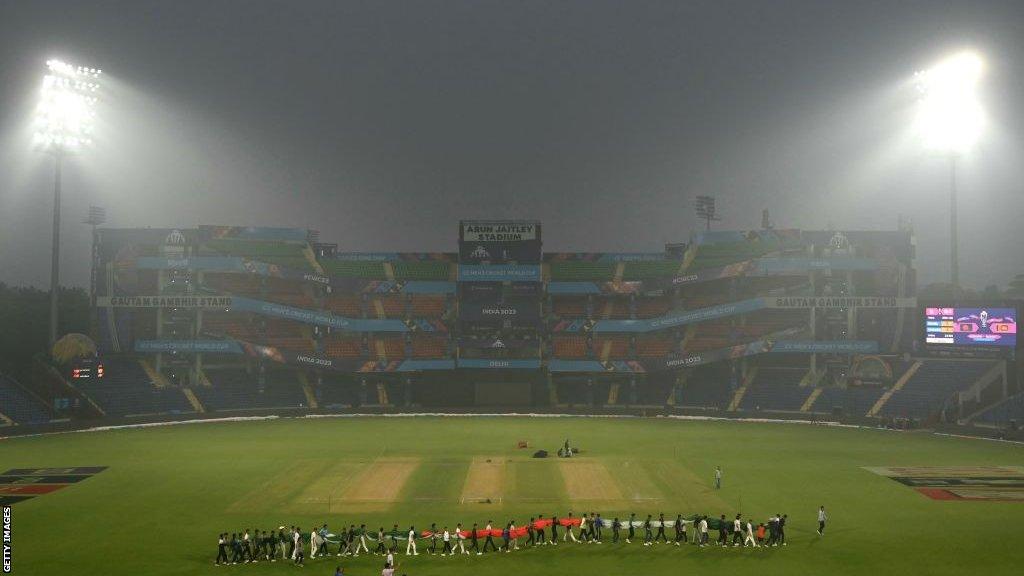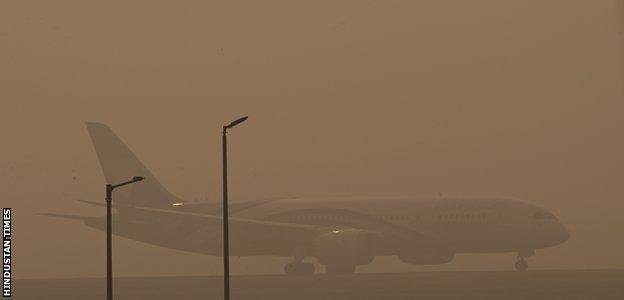Bangladesh v Sri Lanka: Cricket World Cup match goes ahead despite 'very unhealthy' air quality
- Published

The Arun Jaitley Stadium in New Delhi was shrouded in smog on Sunday
The Men's Cricket World Cup match between Bangladesh and Sri Lanka in Delhi went ahead as planned despite poor air quality.
New Delhi's air quality index (AQI) was at 411 - in the "very unhealthy" range - on Monday afternoon and many schools have been closed for the week.
Both teams raised questions over the safety of playing the fixture with the International Cricket Council (ICC).
Bangladesh and Sri Lanka cancelled training sessions before the match.
While Bangladesh did manage to train over the weekend, asthmatic players were left out as the Indian capital topped a real-time list of the world's most polluted cities compiled by IQAir.
The World Health Organisation (WHO) warns against any outdoor activities when the AQI goes over 300, which is regarded as "hazardous".
But independent checks deemed the match safe to take place and mitigating actions have been put in place to make the conditions as safe as possible.
They include the implementation of water sprinklers around the premises and the installation of air purifiers in the dressing rooms and match officials' areas.
Organisers said: "The Board of Control for Cricket in India (BCCI) engaged the services of renowned pulmonologist Dr Randeep Guleria to assess the situation in Delhi ahead of Monday's game and provide independent expert advice.
"The AQI within the stadium was monitored throughout the day, which has reduced to levels considered acceptable by Dr Guleria."
Delhi's air quality at times reached close to the worst possible level of 500 last week. By comparison, London's AQI was 21 on Monday.
Monday's match is the last of five in the World Cup to be held at the Arun Jaitley Stadium.
In 2017 players wore masks during a Test between India and Sri Lanka and two players vomited on the field.

A plane sits on the runway at Delhi airport on 5 November
Explained - Delhi's air pollution problems
BBC India's Geeta Pandey
Monday's match is being played in a city that continues to top the real-time list of the world's most polluted year after year.
The Indian capital is enveloped in an ugly toxic haze of yellow and grey - you can feel the pollution on your skin and taste it in your throat.
On Monday afternoon, government data shows that the city's AQI - the air quality index which monitors the levels of PM2.5, the lung-damaging tiny particles in the air that can cause cancer and cardiac problems - is 411.
In some places, such as the Delhi airport, it is 472. Levels of PM2.5 below 50 are considered "good" and under 100 "satisfactory".
Experts blame the severe pollution on high volumes of traffic, construction activity, burning of crop residue in the neighbouring states of Punjab and Haryana, use of fireworks during the festival season and the start of the cold weather which can trap pollutants in the lower atmosphere for long periods of time.
The authorities, like every year, are struggling to contain the pollution levels.
Schools have been ordered shut until the end of the week, all construction work has been halted and trucks have been barred from entering the city unless carrying essential items like food and medicines.